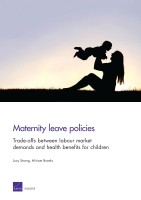| 来源类型 | Research Reports
|
| 规范类型 | 报告
|
| DOI | https://doi.org/10.7249/RR1734
|
| 来源ID | RR-1734-EC
|
| Maternity leave policies: Trade-offs between labour market demands and health benefits for children |
| Lucy Strang; Miriam Broeks
|
| 发表日期 | 2016
|
| 出版者 | RAND Corporation
|
| 出版年 | 2016
|
| 页码 | 21
|
| 语种 | 英语
|
| 结论 |
Breastfeeding initiation and length is linked to maternity leave policies.- Evidence shows a positive link between extending breastfeeding to six months and beyond and improved health benefits for infants and mothers. The length (six months or more) and mode of breastfeeding (especially when exclusive) are crucial in increasing the benefits of breastfeeding.
- Evidence has also found that breastfeeding initiation and duration is related to the characteristics of maternity leave policies (e.g. length, level of pay). Longer duration of maternity leave is linked to longer breastfeeding.
More research is needed on the economic impact of extending maternity leave.- A key issue with extending maternity leave for the benefits of infants' health is that this is potentially at odds with mothers' career prospects. However, the quality of the evidence on the economic implications of extending maternity leave to six months is rather weak, and needs more analysis.
Evidence on the impact of maternity leave is mixed.- Six months of leave is associated with a dip in wages for mothers taking leave, although evidence on the size of this dip is mixed.
- Businesses may also incur costs in relation to productivity and replacing workers on maternity leave, which may directly or indirectly be passed on to female workers. However, existing research suggests that extending maternity leave has a positive effect on women's employment rates: leave periods between 14–26 weeks are associated with a 4.3% increase in the predicted female employment-to-participation ratio.
|
| 摘要 |
- More research needs to be conducted on the question of the economic impact of extended maternity leave on women, families, business and society.
- Policymakers should consider complementary programmes that will facilitate breastfeeding while women participate in the labour market, for example by promoting company policies that encourage breastfeeding at work, such as providing day care facilities or breastfeeding rooms.
- Protections should be put in place to ensure that the career progression of women is not negatively impacted by the extension of maternity leave, and neither female workers nor companies are forced to bear all the financial costs of such schemes.
|
| 主题 | Children
; Children and Families Legislation
; Employment and Unemployment
; Employment Legislation
; European Union
; Maternal Health
; Parenting
|
| URL | https://www.rand.org/pubs/research_reports/RR1734.html
|
| 来源智库 | RAND Corporation (United States)
|
| 引用统计 |
|
| 资源类型 | 智库出版物
|
| 条目标识符 | http://119.78.100.153/handle/2XGU8XDN/108287
|
推荐引用方式
GB/T 7714 |
Lucy Strang,Miriam Broeks. Maternity leave policies: Trade-offs between labour market demands and health benefits for children. 2016.
|
|
文件名:
|
x1495316272174.jpg
|
|
格式:
|
JPEG
|

|
文件名:
|
RAND_RR1734.pdf
|
|
格式:
|
Adobe PDF
|
除非特别说明,本系统中所有内容都受版权保护,并保留所有权利。